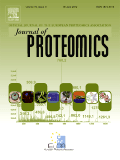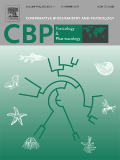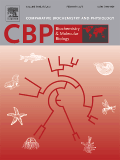
Comparative Biochemistry and Physiology D-Genomics & Proteomics
Scope & Guideline
Innovating Biological Discoveries with High-Impact Research
Introduction
Aims and Scopes
- Comparative Genomics:
The journal emphasizes comparative genomic analyses across species to understand evolutionary relationships and functional adaptations in response to environmental pressures. - Transcriptomic and Proteomic Studies:
A significant focus is placed on transcriptomic and proteomic approaches to elucidate gene expression profiles and protein interactions, which are crucial for understanding physiological adaptations. - Environmental Stress Responses:
Research often investigates the molecular responses of organisms to environmental stressors such as temperature fluctuations, salinity changes, and pollution, highlighting adaptive mechanisms. - Ecological and Evolutionary Insights:
The journal contributes to ecological and evolutionary biology by linking molecular data with ecological outcomes, thereby providing insights into adaptation and survival strategies in various habitats. - Physiological Mechanisms:
There is a strong emphasis on understanding the physiological mechanisms that underpin metabolic processes, immune responses, and development in a variety of organisms, particularly in aquatic species.
Trending and Emerging
- Multi-Omics Approaches:
There is a growing trend towards integrating various omics technologies (genomics, transcriptomics, proteomics, and metabolomics) to provide comprehensive insights into biological processes and responses. - Climate Change and Environmental Adaptation:
Research addressing the impacts of climate change and environmental stressors on organismal physiology is on the rise, reflecting a global interest in understanding how species adapt to rapidly changing conditions. - Functional Genomics and Gene Editing:
The application of functional genomics and gene editing technologies (such as CRISPR) is increasingly featured, focusing on how specific genes contribute to physiological traits and adaptations. - Microbiome Studies:
There is an emerging focus on the role of microbiomes in health and disease, particularly within aquatic species, which is crucial for understanding host-microbe interactions and ecosystem dynamics. - Sexual Dimorphism and Reproductive Biology:
Research exploring sexual dimorphism at the molecular level, particularly in relation to reproductive biology and developmental processes, is gaining traction, highlighting the complexity of sex-related traits.
Declining or Waning
- Traditional Biochemistry Studies:
There has been a noticeable decline in traditional biochemistry studies that do not incorporate genomic or proteomic analyses, as newer methodologies gain prominence in the field. - Single-Species Focus:
Research focusing solely on single species without comparative analysis is becoming less common, as the journal increasingly favors studies that provide comparative insights across different organisms. - Basic Physiological Studies:
Basic physiological studies that do not delve into molecular or genetic mechanisms are appearing less frequently, suggesting a shift towards more integrative approaches that combine physiology with molecular biology.
Similar Journals

Journal of Proteomics
Pioneering advancements in protein analysis and application.Journal of Proteomics, published by Elsevier, is an esteemed peer-reviewed journal dedicated to advancing research in the field of proteomics, with broad implications for biochemistry and biophysics. Established in 2008, the journal has continuously evolved, embracing innovative methodologies and technologies that facilitate protein analysis from a variety of biological systems. With its current standing in the Q2 category for both biochemistry and biophysics as of 2023, it is recognized as a significant contributor to scientific literature. The journal publishes original research articles, reviews, and methodological advancements, providing invaluable insights for researchers, professionals, and students alike. Although it does not offer open access, the journal remains a crucial platform for disseminating knowledge that informs various applications, ranging from drug development to disease understanding. As it converges towards 2024, the Journal of Proteomics continues to solidify its role in shaping the future of proteomic research through rigorous scientific inquiry and innovation.

Proteome Science
Innovating Biological Insights Through ProteomicsProteome Science is an esteemed academic journal specializing in the field of proteomics, providing a platform for advanced research and discussions surrounding the structure, function, and dynamics of proteins in biological systems. Published by BMC, a reputable publisher recognized for its commitment to open-access publishing, Proteome Science has been disseminating pivotal research findings since its inception in 2003. Targeted towards researchers, professionals, and students in biochemistry and molecular biology, the journal aims to foster collaboration and innovation within the scientific community. While it currently holds a Q3 quartile ranking in both Biochemistry and Molecular Biology categories, its impactful contributions to the field are reflected in its accessibility, as evidenced by its open access policy. By embracing collaborative research methodologies and providing a platform for novel findings, Proteome Science plays a crucial role in advancing the understanding of proteomic analyses, catering to a global audience that values groundbreaking scientific discovery.

COMPARATIVE BIOCHEMISTRY AND PHYSIOLOGY C-TOXICOLOGY & PHARMACOLOGY
Connecting Disciplines for a Deeper Understanding of Life SciencesComparative Biochemistry and Physiology C-Toxicology & Pharmacology, published by Elsevier Science Inc, stands as a prominent resource in the fields of pharmacology, toxicology, and biochemical research. With its ISSN 1532-0456 and E-ISSN 1878-1659, this journal has carved out a significant niche, focusing on the comparative aspects of biochemical and physiological data across various species. Recognized for its impact in diverse fields, it boasts a Q1 ranking in Animal Science and Zoology, Aquatic Science, Health, Toxicology and Mutagenesis, alongside respectable standings in other related disciplines. Researchers and professionals can leverage this publication to access high-quality, peer-reviewed studies that advance the understanding of biochemical processes and their toxicological implications. The journal aims to bridge the gap between laboratory findings and real-world applications, fostering an environment for interdisciplinary collaboration. For academics seeking to enhance their knowledge or contribute to this impactful field, Comparative Biochemistry and Physiology C-Toxicology & Pharmacology serves as an invaluable platform.

CELL STRESS & CHAPERONES
Advancing the Science of Cellular ResilienceCELL STRESS & CHAPERONES is a renowned journal that has been at the forefront of advancing our understanding of protein folding, cellular stress responses, and the role of chaperone proteins since its inception in 1996. Published by SPRINGER, this esteemed journal operates out of the Netherlands and serves as a critical platform for researchers in the fields of Biochemistry and Cell Biology. With an impressive impact factor reflecting its credibility—ranked Q2 in Biochemistry and Q3 in Cell Biology for 2023—it showcases rigorous, peer-reviewed research that contributes significantly to the understanding of cellular mechanisms and their implications in health and disease. The journal's commitment to disseminating high-quality research is evident through its indexed status ranking in the Scopus database, identifying it among the top quartile of publications in its respective categories. For scholars and practitioners dedicated to exploring the intricate relationship between cellular stress and physiological responses, CELL STRESS & CHAPERONES provides a vital resource, fostering an interdisciplinary dialogue that enhances the scientific community's collective knowledge.

JOURNAL OF EVOLUTIONARY BIOCHEMISTRY AND PHYSIOLOGY
Exploring the Nexus of Biochemistry and Evolutionary DynamicsJOURNAL OF EVOLUTIONARY BIOCHEMISTRY AND PHYSIOLOGY, published by PLEIADES PUBLISHING INC, is a pivotal periodical that delves into the intricate relationships between biochemical processes and evolutionary dynamics. With its ISSN 0022-0930 and E-ISSN 1608-3202, this journal serves as a comprehensive platform for researchers, professionals, and students dedicated to understanding the physiological adaptations and biochemical mechanisms influenced by evolutionary pressures. Although it is not an open access journal, it offers valuable insights across its historically significant coverage spanning from 1972 to 2017, making it an essential resource for those working in agricultural, biological, and molecular sciences. Despite its current Scopus rankings revealing limited visibility within its fields, the journal remains committed to fostering scholarly dialogue and advancing knowledge in the realm of evolutionary biochemistry, especially for those exploring the ecological, genetic, and integrative physiological aspects of life.

Journal of Experimental Zoology Part A-Ecological and Integrative Physiology
Bridging disciplines to illuminate organismal biology.The Journal of Experimental Zoology Part A - Ecological and Integrative Physiology, published by WILEY, is a distinguished peer-reviewed journal focusing on ecological and evolutionary physiology, providing a robust platform for research that bridges both ecological and integrative physiological concepts. With an impressive impact factor and recognition as a Q1 journal in both Animal Science and Zoology and Ecology, Evolution, Behavior and Systematics in 2023, it positions itself as a leader in advancing our understanding of organismal biology and environmental interactions. The journal is committed to open access, offering researchers and professionals worldwide the opportunity to share and disseminate their findings freely. Since its inception in 2017, it has rapidly gained prominence—ranking within the top percentiles of Scopus Ranks across several disciplines, including genetics and molecular biology. This not only underscores its relevance but also highlights its vital role in facilitating interdisciplinary approaches essential for addressing contemporary biological challenges. Researchers, educators, and students alike will find in this journal a valuable resource for cutting-edge studies and innovative methodologies in the field.

Biology-Basel
Pioneering Research for Tomorrow's SolutionsBiology-Basel is a premier, peer-reviewed open-access journal published by MDPI since 2012, situated in the heart of Switzerland. With an E-ISSN of 2079-7737, this journal serves as a vital platform for the dissemination of innovative research across the broad spectrum of Agricultural and Biological Sciences, Biochemistry, Genetics, Molecular Biology, and Immunology. Recognized for its rigorous editorial standards and impactful findings, it currently ranks Q1 in Agricultural and Biological Sciences and holds impressive positions in several categories according to the 2023 Scopus rankings. The journal’s open-access model ensures that high-quality research is freely available to a global audience, fostering collaboration and knowledge sharing among researchers, professionals, and students alike. Spanning from 2012 to 2024, Biology-Basel is committed to reflecting the latest advancements in biological sciences, making it an essential resource in the ever-evolving landscape of biological research.

COMPARATIVE BIOCHEMISTRY AND PHYSIOLOGY A-MOLECULAR & INTEGRATIVE PHYSIOLOGY
Shaping the Future of Biochemical and Physiological Discovery.Comparative Biochemistry and Physiology A-Molecular & Integrative Physiology, published by Elsevier Science Inc, serves as a pivotal platform for cutting-edge research in the fields of biochemistry, physiology, and animal sciences. The journal, holding an esteemed presence with an ISSN of 1095-6433 and E-ISSN 1531-4332, spans a remarkable history of contributions since its inception in 1960, showcasing significant findings up to 2024. As a Q1 quartile journal in Animal Science and Zoology and featuring competitive rankings across various biochemistry and physiology disciplines, it stands out as a leading resource for both established researchers and emerging scholars alike. The journal is committed to publishing high-quality, peer-reviewed articles that deepen our understanding of molecular and integrative physiology, playing an essential role in advancing scientific knowledge and fostering interdisciplinary collaboration. With access options that prioritize the dissemination of impactful research, Comparative Biochemistry and Physiology continues to shape the dialogue within these dynamic fields.

GENERAL AND COMPARATIVE ENDOCRINOLOGY
Pioneering insights into the endocrine landscape since 1961.GENERAL AND COMPARATIVE ENDOCRINOLOGY, published by Academic Press Inc Elsevier Science, is a distinguished journal that has been at the forefront of endocrine research since its inception in 1961. With an ISSN of 0016-6480 and an E-ISSN of 1095-6840, this journal caters to a diverse audience, including researchers, professionals, and students in the fields of animal science, zoology, and endocrinology. It holds a prestigious Q1 ranking in Animal Science and Zoology and is recognized in the Q3 quartile for Endocrinology, indicating its significant contribution to advancing scientific knowledge. The journal is also well-regarded within the Scopus rankings, with impressive placements in multiple categories, highlighting its impact and relevance in the academic community. By focusing on comparative analyses and fostering a deeper understanding of hormone function and regulation across species, GENERAL AND COMPARATIVE ENDOCRINOLOGY aims to bridge gaps in knowledge and stimulate innovative research paradigms. While it does not currently offer Open Access, the journal remains committed to high-quality peer-reviewed content, making it an essential resource for anyone engaged in this vital field of study.

COMPARATIVE BIOCHEMISTRY AND PHYSIOLOGY B-BIOCHEMISTRY & MOLECULAR BIOLOGY
Bridging Biological Systems Through Molecular InsightsComparative Biochemistry and Physiology B: Biochemistry & Molecular Biology, published by Elsevier Science Inc, is a premier journal dedicated to the field of biochemistry and molecular biology with a specific focus on comparative analyses across various biological systems. Since its inception in 1971, the journal has made significant contributions to our understanding of the biochemical and physiological processes that differentiate organismal function across animal and aquatic life. The journal holds a commendable position in the academic community, evidenced by its 2023 rankings, which place it in the second quartile for Animal Science and Zoology and Aquatic Science, and the third quartile for both Biochemistry and Molecular Biology as well as Physiology. Researchers and students can access cutting-edge research through this highly respected publication, which continues to influence the future of biological sciences. While currently not an Open Access journal, its rigorous peer-review process ensures that only high-quality articles are disseminated, further solidifying its role as a critical resource for professionals and academics alike seeking to explore the intricate relationships between biochemical structures and physiological functions.